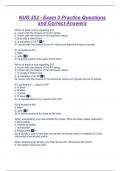Exam (elaborations)
NUR 352 - Exam 3 Practice Questions and Correct Answers
- Course
- Institution
Which of these is true regarding S1? a. occurs with the closure of the AV valves b. occurs with the closure of the semilunar valves c. is usually a silent event d. is indicative of CHF A S1 occurs with the closure of the AV valves and signals the start of systole S1 is loudest at the: a. base b. a...
[Show more]



